- Author Jason Gerald [email protected].
- Public 2023-12-16 10:50.
- Last modified 2025-01-23 12:04.
Minitab is a statistical program that allows you to quickly enter data, and then run various analyzes on that data. You can quickly prepare charts and calculate regressions, and then enter data in a very Excel-like way. Minitab can solve a lot of difficult jobs in statistical calculations.
Step
Part 1 of 4: Entering Data
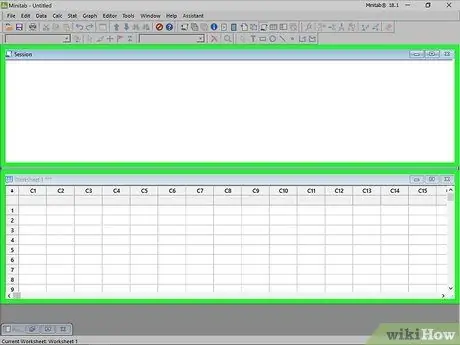
Step 1. Get used to the Minitab layout
When you first start Minitab, two main windows appear: the Session window and the Worksheet window. The Session window will display the analysis output, and the Worksheet window is the place to enter your data. The Worksheet window looks a lot like an Excel worksheet.
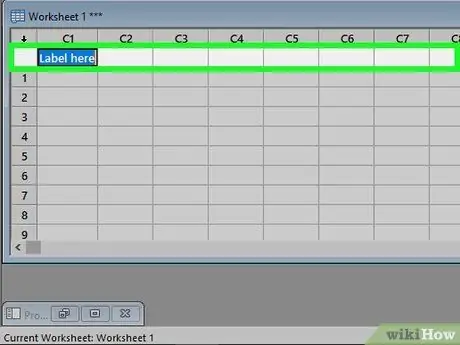
Step 2. Enter your data labels in the second row of the Worksheet
The first row of the worksheet is reserved for labels C1, C2, C3, etc. on the column. The second row is reserved for column labels, which you can enter manually. Just click an empty second row cell and type a label for that column.
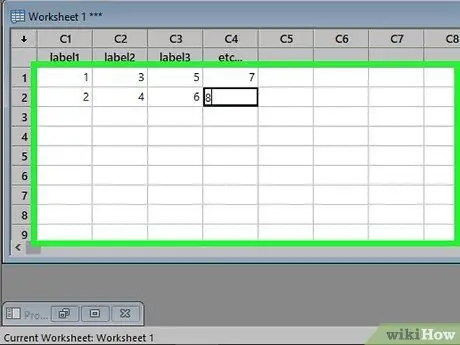
Step 3. Enter all the data into the column
Once the columns have labels, you can start entering data into them. Press Enter to go to the cell below the current cell. If you click the small arrow in the upper left corner of the worksheet, you can change the direction of data entry, so that Enter goes to the next column in the same row.
- If your data is stored in an Excel worksheet, copy and paste it into Minitab. Highlight the data set stored in Excel. Right mouse click and select copy. Open Minitab and click the first cell under C1. Right mouse click and select paste cells.
- Each column must represent one type of data. For example, if you are going to enter information about a baseball team, create one column that contains RBI data, one column contains Errors data, and another contains Home runs data.
Part 2 of 4: Viewing Descriptive Statistics
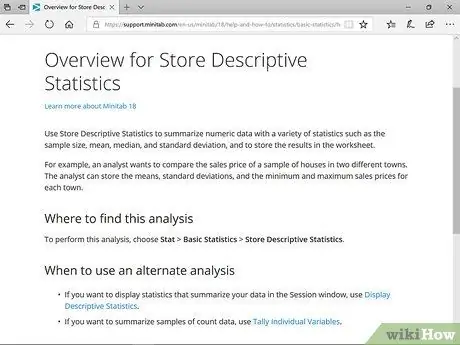
Step 1. Understand what descriptive statistics are
Descriptive statistics summarize a set of data that uses several significant values. Some descriptive statistics include:
- Mean - the arithmetic mean of the data in the column
- Standard deviation - Measuring data dispersion
- Median - The middle value in a data set
- Minimum - The smallest number in a data set
- Maximum - The largest number in a data set
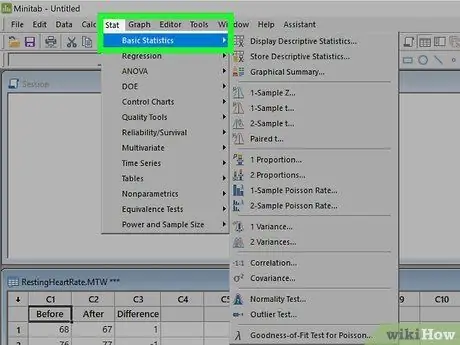
Step 2. Click the Stats menu
After entering the data set, click the Stat menu at the top of the window. Hover the mouse over Basic Statistics.
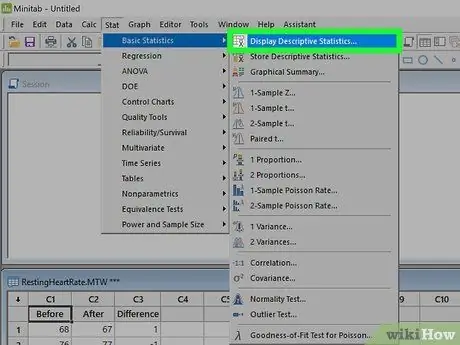
Step 3. Select Display Descriptive Statistics
This will open the Display Descriptive Statistics window, which displays all the columns in the list on the left, and the Variables box on the right.
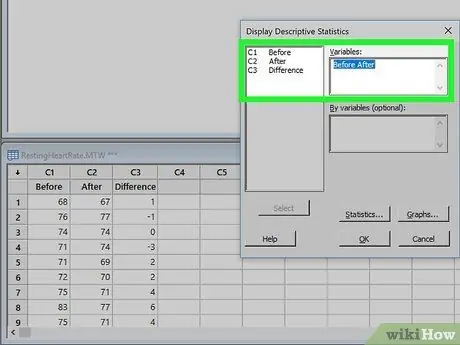
Step 4. Double-click the variable you want to analyze
The variables will appear in the Variables box on the right side of the window.

Step 5. Select the statistics you want to view
Click Statistics… to select the statistics you want to display. You can check or uncheck any box. Click OK when you are done.
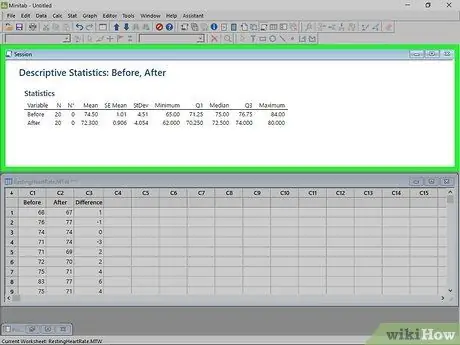
Step 6. Read the output
Click OK in the Display Descriptive Statistics window once you are satisfied with the data set and its statistical options. Descriptive statistics of the selected data will appear in the Session window.
Part 3 of 4: Creating Graphs and Diagrams
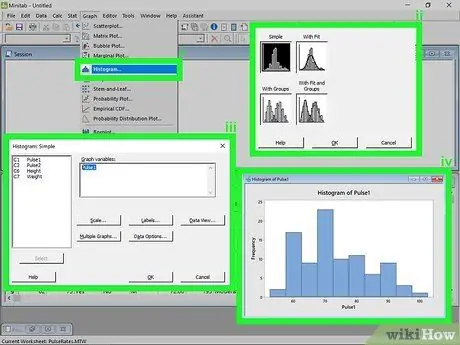
Step 1. Create a histogram
The frequency of the histogram chart corresponds to the category. This allows you to visually see the frequency with which the variable amount of time occurs.
- Click the Graphs menu. After entering the data set, click the Graph menu at the top of the window. Select Histogram…
- Choose your chart type. There are four histogram options: Simple, With Fit, With Outline and Groups, and With Fit and Groups. Select Simple.
- Select your data set. A list of available data sets will be displayed. Double-click the data set for which you want to create a histogram, and then click OK. The histogram will be built and displayed in a new window.
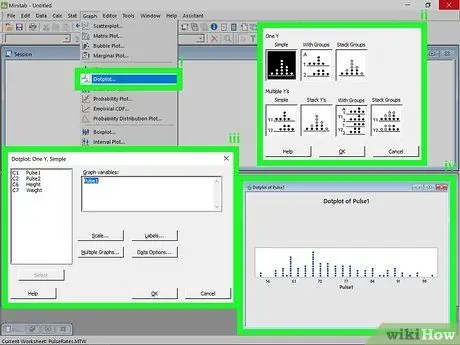
Step 2. Create a point plot
Much like a histogram, a point plot shows which values fall into a particular category. It is especially suitable for small data sets.
- Click the Graphs menu. After entering the data set, click the Graph menu at the top of the window. Select Dotplot….
- Select a chart type. You can choose from seven options when creating a point plot. Select Simple to create a point plot from a single column of data.
- Select your data set. A list of available data sets will appear. Double-click the data set whose point plot you want to create, and then click OK. The dot plot will appear in a new window.
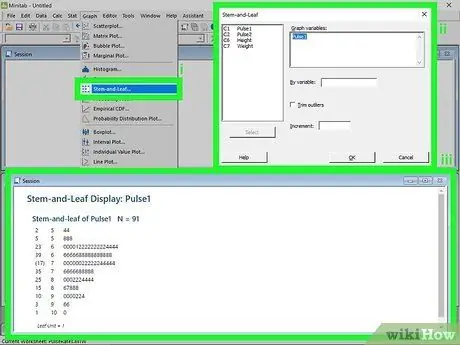
Step 3. Create a leaf stem plot
The stem-leaf plot is also similar to a histogram, showing the frequency with which values occur. The actual numbers will be displayed in each category, and there is no visual aspect to it.
- Click the Graphs menu. After entering the data set, click the Graph menu at the top of the window. Choose Stem-and-Leaf….
- Select your data set. A list of available data sets will appear. Double-click the data set whose stem-leaf plot you want to create, and then click OK. The leaf stem plot will appear in the Session window.
- Look up the Wikihow article for more details on stem-leaf plots.
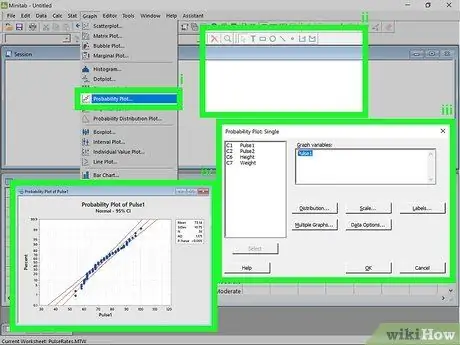
Step 4. Create a probability plot
This plot allows you to quickly identify outliers and other departures from a normal curve.
- Click the Graphs menu. After entering the data set, click the Graph menu at the top of the window. Select Probability Plot….
- Choose your chart type. There are two options for constructing a probability plot. Select Single for now.
- Select your data set. A list of available data sets will appear. Double-click the data set whose probability plot you want to create, and then click OK. The probability plot will appear in a new window.
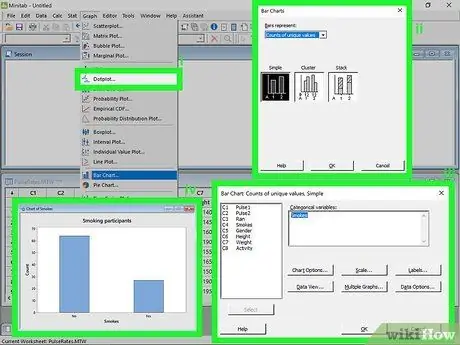
Step 5. Create a bar chart
Bar charts allow you to visually present data. This chart differs from the histogram in that each column in the histogram presents quantitative variables, while the columns in the bar chart represent categorical variables.
- Click the Graphs menu. After entering the data set, click the Graph menu at the top of the window. Choose a bar chart…
- Choose what the bar will wikipedia. Use the drop-down menu to choose what bar to represent: the number of unique values, a variable function, or values from a table.
- Select a chart type. Usually what is selected is the Simple bar chart.
- Select your data set. A list of available data sets will appear. Double-click the data set whose bar chart you want to create. You can also add labels to the chart by clicking the Labels… button. Click OK to create a bar chart in a new window.

Step 6. Create a pie chart
A pie chart functions like a bar chart but in the form of pie slices that represent categorical variables.
- Click the Graphs menu. After entering the data set, click the Graph menu at the top of the window. Choose Pie Charts…
- Select your data set. A list of available data sets will appear. Double-click the data set whose pie chart you want to create. You can also add labels to the chart by clicking the Labels… button. Click OK to create the pie chart in a new window.
Part 4 of 4: Running a Regression Analysis
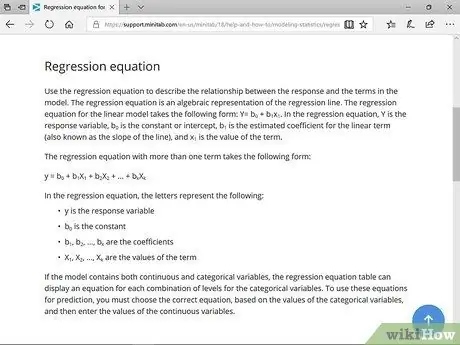
Step 1. Understand what regression analysis does
Regression analysis demonstrates the relationship between random variables. There are two types of variables in regression analysis: response variables and predictors. The value of the chosen predictor variable predicts the value of the response variable, and regression analysis (among other things) will determine how accurate this prediction trend is.
Y usually represents the response variable, and X usually represents the predictor variable
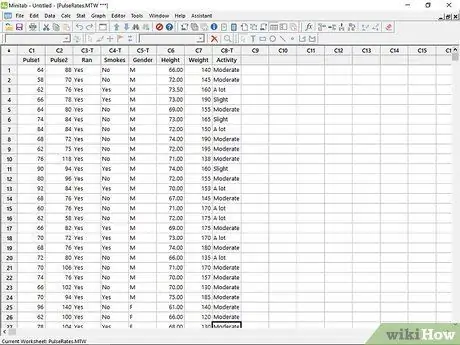
Step 2. Create your data set
Enter the response variables and their respective predictors in separate columns. Make sure that each column is properly labeled in the second row.
- Response Variable: Measured in an experiment. Also called the dependent variable.
- Predictor Variables: Variables whose values determine changes in other variables. Also called the independent variable.
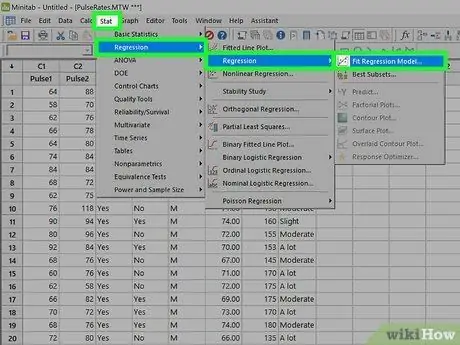
Step 3. Open the Regression wizard
Click the Stat menu and hover the mouse over Regression, then select Regression….
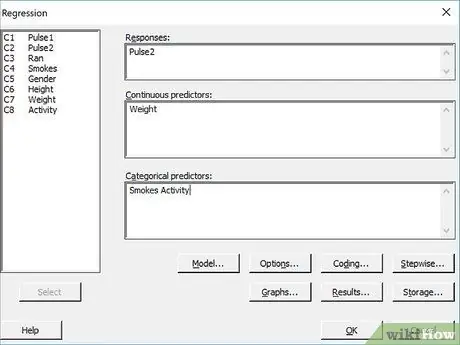
Step 4. Add all your variables
Double-click on the data set that is the response, or dependent variable. This will add it to the Response column. Then double-click on the data set that is the predictor variable, or independent. This will add it to the Predictor column. You can add multiple variables to the Predictor field.
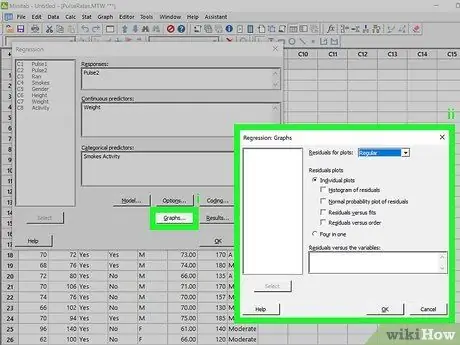
Step 5. Select any chart
If you want to generate a graph alongside the analysis, click the Graphs… button. You can then select the graph and residue you want to create. Click OK after making your selection.
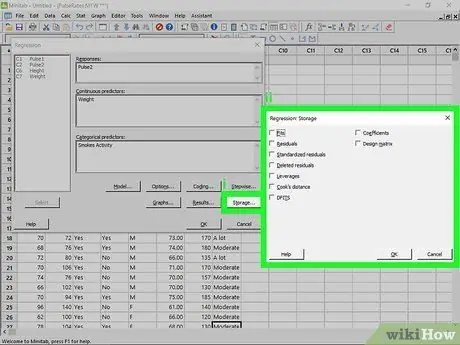
Step 6. Choose whether to save the result
You can choose whether Minitab saves your results, such as your residuals and matches. Click the Storage button to select the aspects you want to save. Everything will be added to a new column in your worksheet.

Step 7. Run a regression analysis
When you are finished configuring the options, click OK in the regression window. Minitab will calculate the regression and display any chart and stored values that you specify.
- In Minitab, the regression analysis output appears in the Session window.
- The regression equation provides an estimate of how X predicts Y.
- P-values determine the significance of the predictor variables.
- R-sq describes how well the data fits the model (1 and -1 indicate perfect fit).






